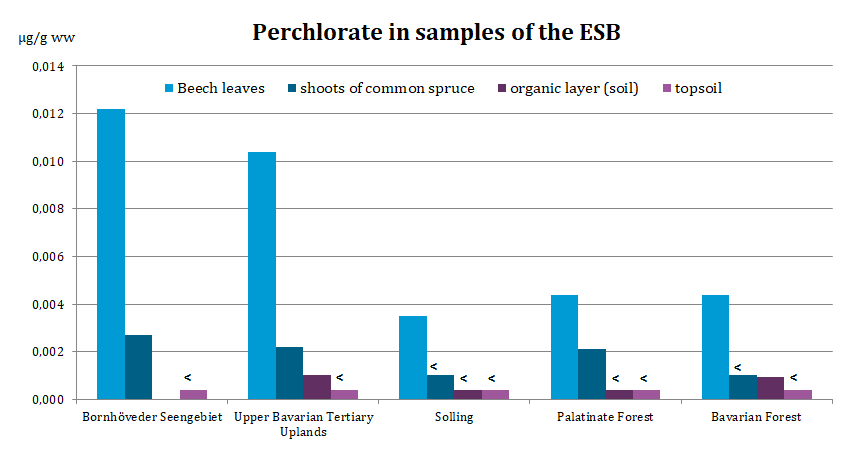Perchlorate - background exposure of different environmental matrices
Investigations of precipitation water, soil, and tree samples
Perchlorate contamination of fruit and vegetables is a reoccurring problem. Thus, the German Environment Agency (UBA) started an investigation of different environmental matrices and precipitation water samples of the UBA monitoring network to measure perchlorate background exposure in 2013.
Findings
Precipitation water
In none of the 24 analyzed samples of the six monitoring stations of the UBA air-monitoring network a perchlorate concentration over the limit of quantification of 0.1 µg/L could be detected. The samples were gathered from September until November of 2013.
Samples from the Environmental Specimen Bank
To investigate the background exposure to perchlorate in soil and plants, UBA used samples from the Environmental Specimen Bank (ESB).
The specimen types soil, beech leaves and one-year-old shoots of common spruce originated from five different sampling areas of the ESB. The areas are distributed over the whole of Germany and are categorized in three different ecosystems: agrarian, forestry and nearly natural terrestrial ecosystems.
Not all sampling areas are used for yearly sampling; thus, the investigated samples differ in years of sampling. In November 2013 the up to that point latest samples of the ESB-archive were used.
Soil: organic layer and topsoil
Concerning the soil samples, the organic layer and topsoil, as far as available, were investigated. The samples originated from the year 2010 (at the ESB routinely sampling of soil is done every four years).
Perchlorate could not be detected in most of the analyzed samples. Only in the organic layer of the Upper Bavarian Tertiary Upland and the Bavarian Forest National Park perchlorate concentrations of approximately 0.001 µg/g ww could be shown (see figure 1).
It is important to note, that in Bornhöved no organic layer could be sampled because the area is used as cultivated area.

Beech leaves and one-year-old shoots of common spruce
The used samples originated from the following sampling years:
2011: beech leaves from Bornhöved Lake District, Solling, Palatinate Forest
2012: beech leaves from Bavarian Forest National Park, Upper Bavarian Tertiary Uplands
2012: one-year-old shoots of common spruce Upper Bavarian Tertiary Uplands
2013: one-year-old shoots of common spruce Bavarian Forest National Park, Bornhöved Lake District, Solling, Palatinate Forest
As plant representative beech leaves and one-year-old shoots of common spruce were chosen. All analyzed values were under the reference values for food published by the Panel on Contaminants in the Food Chain (CONTAM) of the European Food Safety Authority (EFSA) in 2015 of 0.02 – 1.0 µg/g (mg/kg).
Interestingly beech leaves show far higher concentrations of perchlorate than common spruce or soil samples. It can be deduced, that perchlorate seems to enter the plants during the vegetation period. Additionally the leave samples of the agrarian ecosystems are exposed higher than samples of the other three ecosystems.
The results indicate that perchlorate exposure of produce is not directly linked to background exposure.
Updated at: 2022-01-11
Recommended profiles
Specimen
-
A major primary producer in semi-natural and anthropogenic affected ecosystems.
-
As the most dominant deciduous tree species in Central Europe, it plays a significant role in most nearly natural and also anthropogenically influenced forest ecosystems up to an altitude of 1100 m.
-
Soil is livelihood and biosphere for humans, animals, plants and soil organisms. All the substances brought in are transported, transformed and/or accumulated in the soil.
Analytes
-
Salts of perchloric acid
Sampling area
-
Second highest and largest low mountain range in Northern Germany
-
Germany's largest connected forest area in a range of low mountains
-
The Upper Bavarian Tertiary Uplands are a part of the Southern German Molasse Basin
-
Main water divide between the North- and Baltic Sea
-
Germany's first national park
Extended information
Links to external information and legislation
Literature
-
Untersuchung von Proben der Umweltprobenbank des Bundes (UPB) und Niederschlagswasser auf Perchlorat
Schulz, Volker
Jena: FOOD GmbH Jena Analytik-Consulting, 2014. - 9, Projektnummer (31 382), 2014